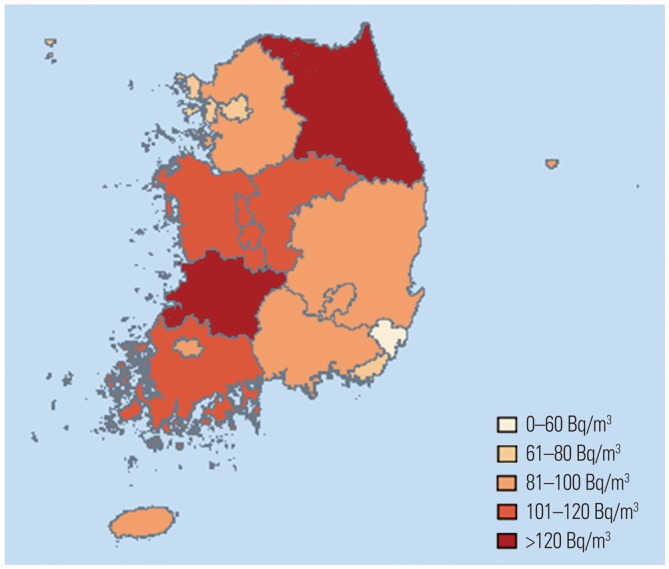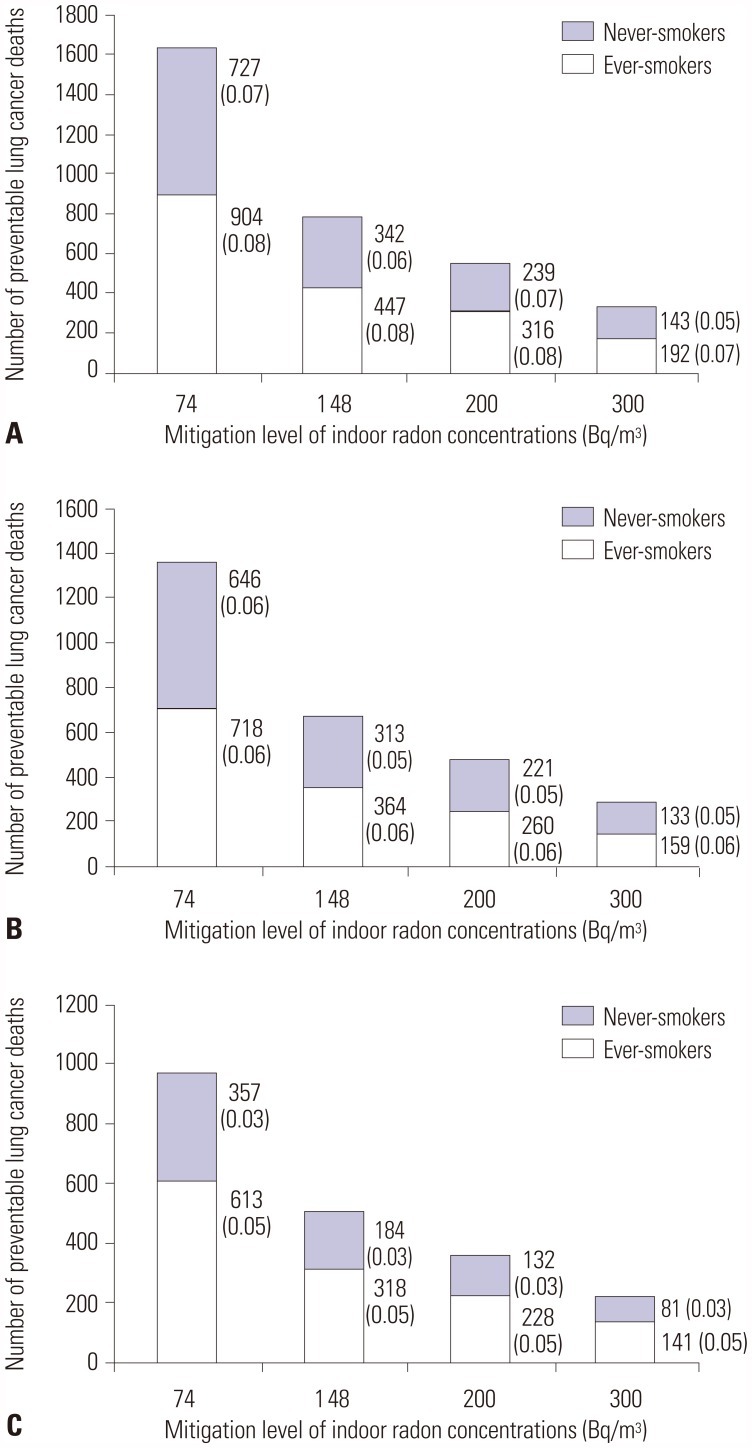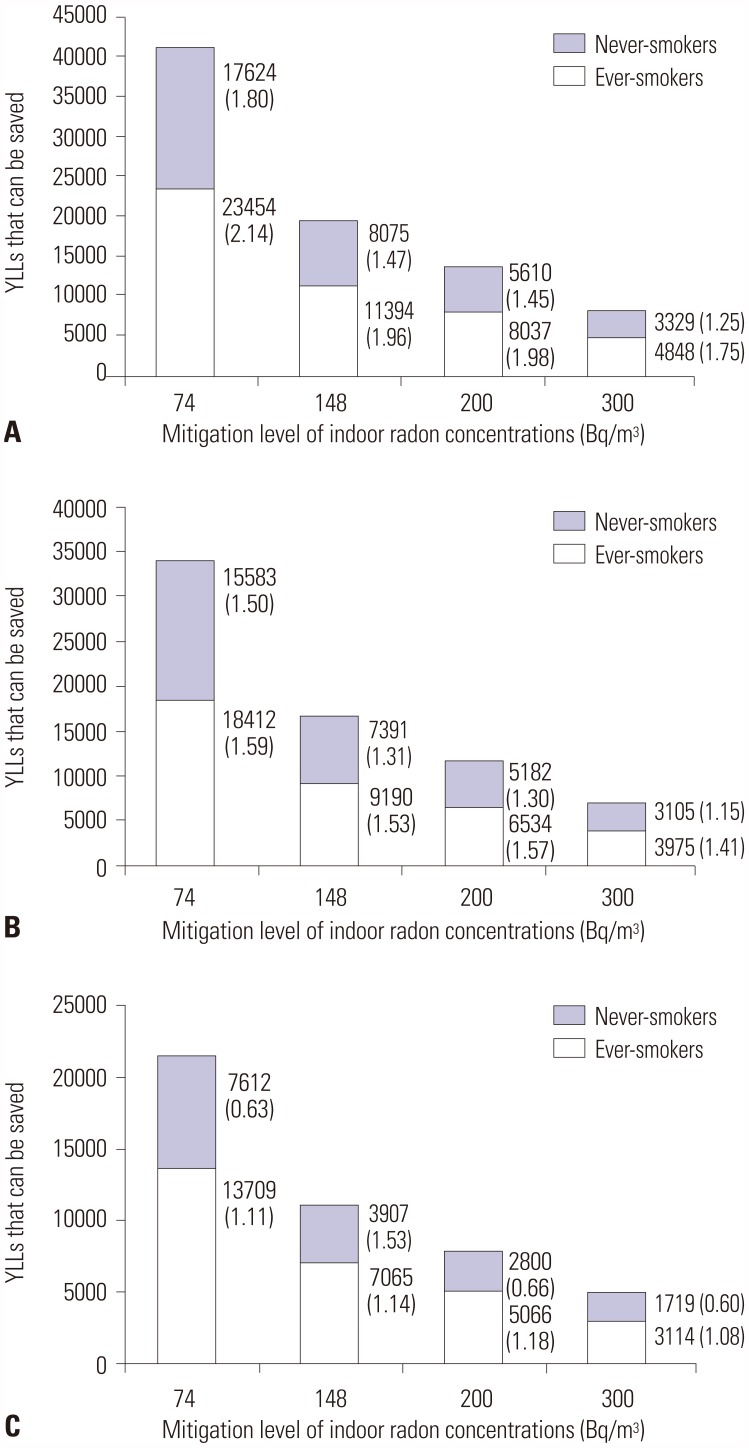Yonsei Med J.
2018 Nov;59(9):1123-1130. 10.3349/ymj.2018.59.9.1123.
Indoor Radon and Lung Cancer: Estimation of Attributable Risk, Disease Burden, and Effects of Mitigation
- Affiliations
-
- 1Department of Preventive Medicine and Public Health, Ajou University School of Medicine, Suwon, Korea.
- 2Department of Preventive Medicine, Yonsei University Wonju College of Medicine, Wonju, Korea.
- 3Department of Chemical and Biological Engineering, Seokyeong University, Seoul, Korea.
- 4Department of Preventive Medicine, Yonsei University College of Medicine, Seoul, Korea.
- 5Center of Biomedical Data Science/Institute of Genomic Cohort, Yonsei University Wonju College of Medicine, Wonju, Korea. dr.kang@yonsei.ac.kr
- KMID: 2422498
- DOI: http://doi.org/10.3349/ymj.2018.59.9.1123
Abstract
- PURPOSE
Exposure to indoor radon is associated with lung cancer. This study aimed to estimate the number of lung cancer deaths attributable to indoor radon exposure, its burden of disease, and the effects of radon mitigation in Korea in 2010.
MATERIALS AND METHODS
Lung cancer deaths due to indoor radon exposure were estimated using exposure-response relations reported in previous studies. Years of life lost (YLLs) were calculated to quantify disease burden in relation to premature deaths. Mitigation effects were examined under scenarios in which all homes with indoor radon concentrations above a specified level were remediated below the level.
RESULTS
The estimated number of lung cancer deaths attributable to indoor radon exposure ranged from 1946 to 3863, accounting for 12.5-24.7% of 15623 total lung cancer deaths in 2010. YLLs due to premature deaths were estimated at 43140-101855 years (90-212 years per 100000 population). If all homes with radon levels above 148 Bq/m3 are effectively remediated, 502-732 lung cancer deaths and 10972-18479 YLLs could be prevented.
CONCLUSION
These findings suggest that indoor radon exposure contributes considerably to lung cancer, and that reducing indoor radon concentration would be helpful for decreasing the disease burden from lung cancer deaths.
Keyword
Figure
Cited by 1 articles
-
Indoor Radon and Lung Cancer: National Radon Action Plans Are Urgently Required
Hae-Seong Nam, Jeong-Seon Ryu
Yonsei Med J. 2018;59(9):1013-1014. doi: 10.3349/ymj.2018.59.9.1013.
Reference
-
1. National Research Council. Health effects of exposure to radon: BEIR VI. Washington, DC: National Academy Press;1999.2. International Agency for Research on Cancer. Man-made mineral fibres. Man-made mineral fibres. IARC Monogr Eval Carcinog Risks Hum. 1988; 43:39–171. PMID: 3065211.3. Chen J, Moir D, Whyte J. Canadian population risk of radon induced lung cancer: a re-assessment based on the recent cross-Canada radon survey. Radiat Prot Dosimetry. 2012; 152:9–13. PMID: 22874897.
Article4. World Health Organization. WHO handbook on indoor radon: a public health perspective. Geneva: World Health Organization;2009.5. Darby S, Hill D, Auvinen A, Barros-Dios JM, Baysson H, Bochicchio F, et al. Radon in homes and risk of lung cancer: collaborative analysis of individual data from 13 European case-control studies. BMJ. 2005; 330:223. PMID: 15613366.
Article6. Darby S, Hill D, Deo H, Auvinen A, Barros-Dios JM, Baysson H, et al. Residential radon and lung cancer--detailed results of a collaborative analysis of individual data on 7148 persons with lung cancer and 14,208 persons without lung cancer from 13 epidemiologic studies in Europe. Scand J Work Environ Health. 2006; 32(Suppl 1):1–83.7. Krewski D, Lubin JH, Zielinski JM, Alavanja M, Catalan VS, Field RW, et al. Residential radon and risk of lung cancer: a combined analysis of 7 North American case-control studies. Epidemiology. 2005; 16:137–145. PMID: 15703527.8. Krewski D, Lubin JH, Zielinski JM, Alavanja M, Catalan VS, Field RW, et al. A combined analysis of North American case-control studies of residential radon and lung cancer. J Toxicol Environ Health A. 2006; 69:533–597. PMID: 16608828.
Article9. Lubin JH, Wang ZY, Boice JD Jr, Xu ZY, Blot WJ, De Wang L, et al. Risk of lung cancer and residential radon in China: pooled results of two studies. Int J Cancer. 2004; 109:132–137. PMID: 14735479.
Article10. Kim SH, Hwang WJ, Cho JS, Kang DR. Attributable risk of lung cancer deaths due to indoor radon exposure. Ann Occup Environ Med. 2016; 28:8. PMID: 26925236.
Article11. GBD 2013 Risk Factors Collaborators. Forouzanfar MH, Alexander L, Anderson HR, Bachman VF, Biryukov S, Brauer M, et al. Global, regional, and national comparative risk assessment of 79 behavioural, environmental and occupational, and metabolic risks or clusters of risks in 188 countries, 1990-2013: a systematic analysis for the Global Burden of Disease Study 2013. Lancet. 2015; 386:2287–2323. PMID: 26364544.12. Lee CM, Kang DY, Koh SB, Cho YS, Lee DJ, Lee SB. Development of predictive model for annual mean radon concentration for assessment of annual effective dose of radon exposure. J Environ Sci Int. 2016; 25:1107–1114.
Article13. Pinel J. Fearn T, Darby SC, Miles JCH. Seasonal correction factors for indoor radon measurements in the United Kingdom. Radiat Prot Dosimetry. 1995; 58:127–132.14. Yun YD, Back JH, Ghang H, Jee SH, Kim Y, Lee SM, et al. Hazard ratio of smoking on lung cancer in Korea according to histological type and gender. Lung. 2016; 194:281–289. PMID: 26718701.
Article15. Lubin JH, Boice JD, Edling C, Hornung RW, Howe G, Kunz E. Radon and lung cancer risk: a joint analysis of 11 underground miners studies. Bethesda (MD): National Institutes of Health;1994.16. World Health Organization. WHO methods and data sources for global burden of disease estimates 2000-2011. Geneva: World Health Organization;2013.17. Catelinois O, Rogel A, Laurier D, Billon S, Hemon D, Verger P, et al. Lung cancer attributable to indoor radon exposure in France: impact of the risk models and uncertainty analysis. Environ Health Perspect. 2006; 114:1361–1366. PMID: 16966089.
Article18. Lee HA, Lee WK, Lim D, Park SH, Baik SJ, Kong KA, et al. Risks of lung cancer due to radon exposure among the regions of Korea. J Korean Med Sci. 2015; 30:542–548. PMID: 25931783.
Article19. Veloso B, Nogueira JR, Cardoso MF. Lung cancer and indoor radon exposure in the north of Portugal--an ecological study. Cancer Epidemiol. 2012; 36:e26–e32. PMID: 22075535.20. Advisory Group on Ionising Radiation. Radon and public health. Oxford: Health Protection Agency;2009.21. Menzler S, Piller G, Gruson M, Rosario AS, Wichmann HE, Kreienbrock L. Population attributable fraction for lung cancer due to residential radon in Switzerland and Germany. Health Phys. 2008; 95:179–189. PMID: 18617799.
Article22. Yoon SJ, Kim HS, Ha J, Kim EJ. Measuring the environmental burden of disease in South Korea: a population-based study. Int J Environ Res Public Health. 2015; 12:7938–7948. PMID: 26184265.
Article23. Hänninen O, Knol AB, Jantunen M, Lim TA, Conrad A, Rappolder M, et al. Environmental burden of disease in Europe: assessing nine risk factors in six countries. Environ Health Perspect. 2014; 122:439–446. PMID: 24584099.
Article24. Lubin JH, Boice JD Jr. Estimating Rn-induced lung cancer in the United States. Health Phys. 1989; 57:417–427. PMID: 2777548.
Article25. Brand KP, Zielinski JM, Krewski D. Residential radon in Canada: an uncertainty analysis of population and individual lung cancer risk. Risk Anal. 2005; 25:253–269. PMID: 15876202.
Article26. Peterson E, Aker A, Kim J, Li Y, Brand K, Copes R. Lung cancer risk from radon in Ontario, Canada: how many lung cancers can we prevent? Cancer Causes Control. 2013; 24:2013–2020. PMID: 23982909.
Article27. Darby S, Hill D, Doll R. Radon: a likely carcinogen at all exposures. Ann Oncol. 2001; 12:1341–1351. PMID: 11762803.
Article28. Organisation for Economic Co-operation and Development. OECD health statistics 2016. accessed on 2016 November 9. Available at: http://www.oecd.org/els/health-systems/health-data.htm.
- Full Text Links
- Actions
-
Cited
- CITED
-
- Close
- Share
- Similar articles
-
- Attributable risk of lung cancer deaths due to indoor radon exposure
- The Disease Burden of Lung Cancer Attributable to Residential Radon Exposure in Korean Homes
- An updated review of case–control studies of lung cancer and indoor radon-Is indoor radon the risk factor for lung cancer?
- A review on mathematical models for estimating indoor radon concentrations
- Indoor Radon and Lung Cancer: National Radon Action Plans Are Urgently Required




